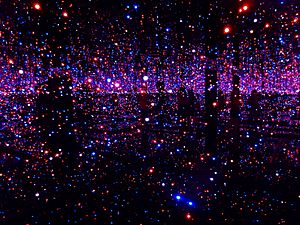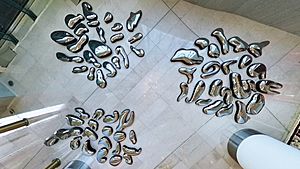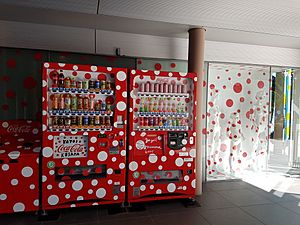Yayoi Kusama facts for kids
Quick facts for kids
Yayoi Kusama
草間 彌生 |
|
|---|---|

Wax model (2012)
|
|
| Born |
Yayoi Kusama (草間 彌生)
22 March 1929 |
| Nationality | Japanese |
| Known for |
|
| Movement |
|
| Awards | Praemium Imperiale |
Yayoi Kusama (草間 彌生, Kusama Yayoi, born 22 March 1929) is a Japanese modern artist. She mostly creates sculpture and installation art. She also works in painting, performance, video art, fashion, poetry, and writing.
Yayoi Kusama is known as one of the most important living artists from Japan. She is also one of the world's most famous and successful living artists. Her unique art style influenced other well-known artists like Andy Warhol.
Contents
- Early Life and Art Beginnings
- World War II and Early Career
- Early Success in Japan: 1950–1956
- New York City: 1957–1972
- Return to Japan: 1973–1977
- Revival: 1980s–Present
- Works and Publications
- Art Collections Worldwide
- Awards and Recognition
- Personal Connections
- Interesting Facts About Yayoi Kusama
- Yayoi Kusama Quotes
- Images for kids
- See also
Early Life and Art Beginnings
Yayoi Kusama was born on March 22, 1929, in Matsumoto, Nagano. Her family were merchants. From a young age, Kusama loved to draw. She often drew things she saw during vivid hallucinations. These visions later became a big part of her art.
When she was ten, Kusama started seeing "flashes of light" and "dense fields of dots." She also saw flowers that seemed to talk to her. These patterns and visions became a way for her to escape from her difficult childhood.
World War II and Early Career
When Kusama was 13, she worked in a military factory during World War II. She helped make parachutes for the Japanese army. She remembers hearing air-raid alerts and seeing American planes flying overhead.
This time made her value personal and creative freedom even more. After the war, she studied traditional Japanese painting in Kyoto. But she was more interested in new European and American art styles. She held her first art shows in Japan in the 1950s.
Early Success in Japan: 1950–1956
By 1950, Kusama was creating abstract art using watercolors, gouache, and oil paints. She began covering surfaces like walls, floors, and canvases with polka dots. These dots soon became her artistic trademark.
She called her large fields of polka dots "infinity nets." These patterns came directly from her hallucinations. One of her earliest drawings from 1939 shows a Japanese woman covered in spots. Her first big paintings, called Infinity Nets, were completely covered in these net and dot patterns.
New York City: 1957–1972
At age 27, Kusama moved from Japan to the United States. She first lived in Seattle for a year, where she had an art show. Then, in 1957, she moved to New York City. There, she quickly became a leading artist in the new art movement. She earned much praise for her work.
In the early 1960s, Kusama started making "soft sculptures." She often posed for photos with her new art. She also wore her signature bob wigs and colorful, unique clothes in public.
Since 1963, Kusama has created her famous Mirror/Infinity rooms. These are special rooms lined with mirrors. Inside, many neon-colored balls hang at different heights. When you stand on a small platform inside, the lights reflect endlessly. This creates the feeling of a never-ending space.
During these years, Kusama was very busy and creative. By 1966, she was making large art installations that filled entire rooms. These works included mirrors, lights, and even music.
Return to Japan: 1973–1977
In 1973, Kusama returned to Japan because she was not feeling well. She began writing surreal novels, short stories, and poetry. In 1977, Kusama chose to live in a hospital for her well-being. She has lived there ever since. Her art studio is close by in Tokyo, where she continues to create art.
From her studio, she has kept making art in many different ways. She also started a writing career, publishing several novels and poems. Her painting style changed to bright acrylic colors on large canvases.
Revival: 1980s–Present

After Kusama left New York, she was almost forgotten as an artist. But in the late 1980s and 1990s, her work became popular again.
In 1993, Japan's art display at the Venice Biennale was a big success. After this, Kusama created a huge yellow pumpkin sculpture covered with black spots. This 2.5-meter-wide "Pumpkin" was made of strong plastic. It was placed on a pier in Naoshima, Kagawa in 1994 and became very famous.

Kusama continued to work as an artist even in her nineties. She returned to drawing and painting, like her earlier works. Her art remained fresh and included many different styles.
In 2017, the Yayoi Kusama Museum opened in Tokyo, showing her amazing artworks.
The Pérez Art Museum Miami recently showed Kusama's work in South Florida. Her exhibition, Yayoi Kusama: LOVE IS CALLING, will be open to the public through 2024.
Works and Publications
Film
In 1968, Kusama worked with Jud Yalkut on a film called Kusama's Self-Obliteration. This film won awards at several festivals. The 1967 experimental film showed Kusama painting polka dots on everything around her.
In 1991, Kusama acted in the movie Tokyo Decadence. In 1993, she worked with musician Peter Gabriel on an art installation in Yokohama.
Fashion
In 1968, Kusama started Kusama Fashion Company Ltd. She began selling unique, avantgarde fashion. In 2009, Kusama designed special cell phones for a Japanese company. These phones included a "Handbag for Space Travel" phone and a pink dotted phone shaped like a dog.
In 2011, Kusama created artwork for six special lipglosses for Lancôme. That same year, she worked with designer Marc Jacobs on a line of Louis Vuitton products. These included bags, clothes, shoes, and jewelry. Louis Vuitton created a second collection of her designs in 2023.
Writing
In 1977, Kusama published a book of poems and paintings called 7. Her first novel came out a year later. Between 1983 and 1990, she wrote several more novels. She also published issues of a magazine called S&M Sniper with photographer Nobuyoshi Araki.
Her most recent book is her autobiography, Infinity Net, published in 2003. It tells her life story, from growing up in Japan to moving to the United States and then returning home. Infinity Net also includes her poetry and photos of her art shows.
Public Art Commissions
Kusama has created many large outdoor sculptures for public places. These include Pumpkin (1994) for the Fukuoka Municipal Museum of Art. She also made The Visionary Flowers (2002) for the Matsumoto City Museum of Art.
Other works include Red Pumpkin (2006) for Naoshima Town and The Hymn of Life: Tulips (2007) for Beverly Gardens Park in Los Angeles. In 1998, she painted a mural for a subway station in Lisbon. Her outdoor sculptures are made from strong plastic and painted to be shiny and perfect.
In 2011, she designed the front cover for millions of pocket London Underground maps. The design was called Polka Dots Festival in London.
Art Collections Worldwide
Kusama's art is displayed in museums all over the world. You can find her work at the Museum of Modern Art in New York. It's also at the Tate Modern in London and the Centre Pompidou in Paris.
Her art is also in the National Museum of Modern Art in Tokyo. In her hometown, the Matsumoto City Museum of Art has a special place for her art called "The Place for My Soul."
Awards and Recognition
Kusama has received many important awards. These include the Asahi Prize (2001) and the Ordre des Arts et des Lettres (2003). In 2006, she received the National Lifetime Achievement Award from the Order of the Rising Sun.
In October 2006, Kusama became the first Japanese woman to receive the Praemium Imperiale. This is one of Japan's highest honors for international artists. She also received the Person of Cultural Merit (2009).
In 2017, Kusama worked with the Hirshhorn Museum and Sculpture Garden. They made her Infinity Mirror rooms easier for visitors with disabilities to experience. They used virtual reality to let everyone explore the rooms as if they were walking through them.
Personal Connections
When Kusama lived in New York, she had a friendship with artist Donald Judd. She also had a close, but not romantic, friendship with surrealist artist Joseph Cornell. They would talk daily and send each other drawings and collages. Their friendship lasted until Cornell's death in 1972.
Interesting Facts About Yayoi Kusama
- Kusama's painting White No. 28 (1960) sold for $7.1 million in 2014. This made her the most expensive living female artist at auction at that time.
- In 2010, Kusama designed a special bus for her hometown of Matsumoto. It was covered in her signature dots.
- As of 2012, her art had the highest sales of any living woman artist.
- In 2014, Kusama was named the most popular artist of the year.
Yayoi Kusama Quotes
- "My life is a dot lost among thousands of other dots."
- "Every time I have had a problem, I have confronted it with the ax of art."
- "I have a flood of ideas in my mind. I just follow my vision."
- "I, Kusama, am the modern Alice in Wonderland."
Images for kids
-
Yayoi Kusama's Ascension of Polka Dots on the Trees at the Singapore Biennale 2006 on Orchard Road, Singapore
-
Yayoi Kusama's Ascension of Polka Dots on the Trees at the Singapore Biennale 2006 on Orchard Road, Singapore
-
An Infinity Mirrored Room installation by Yayoi Kusama at the Crystal Bridges Museum of American Art.
-
The Spirits of the Pumpkins Descended into the Heavens (2017), National Gallery of Australia, Canberra, Australia
See also
 In Spanish: Yayoi Kusama para niños
In Spanish: Yayoi Kusama para niños






















